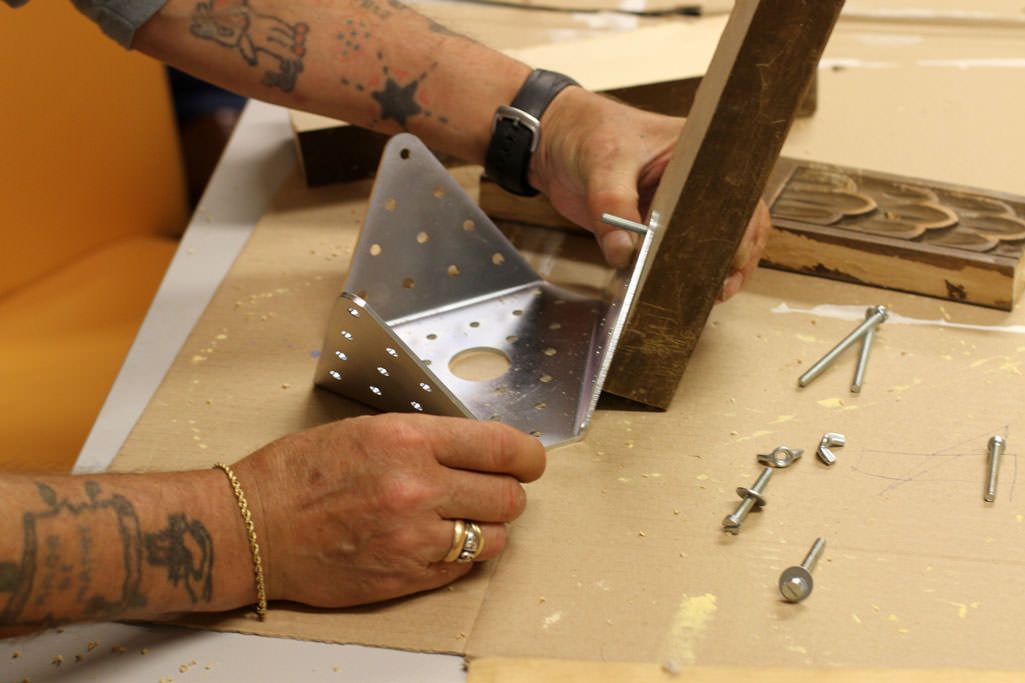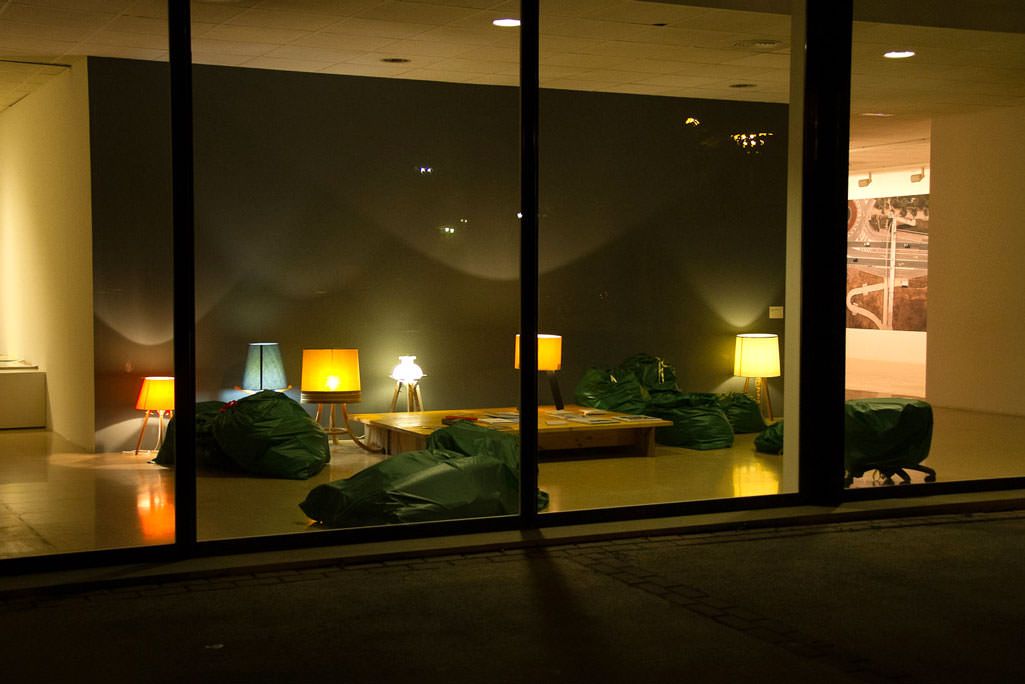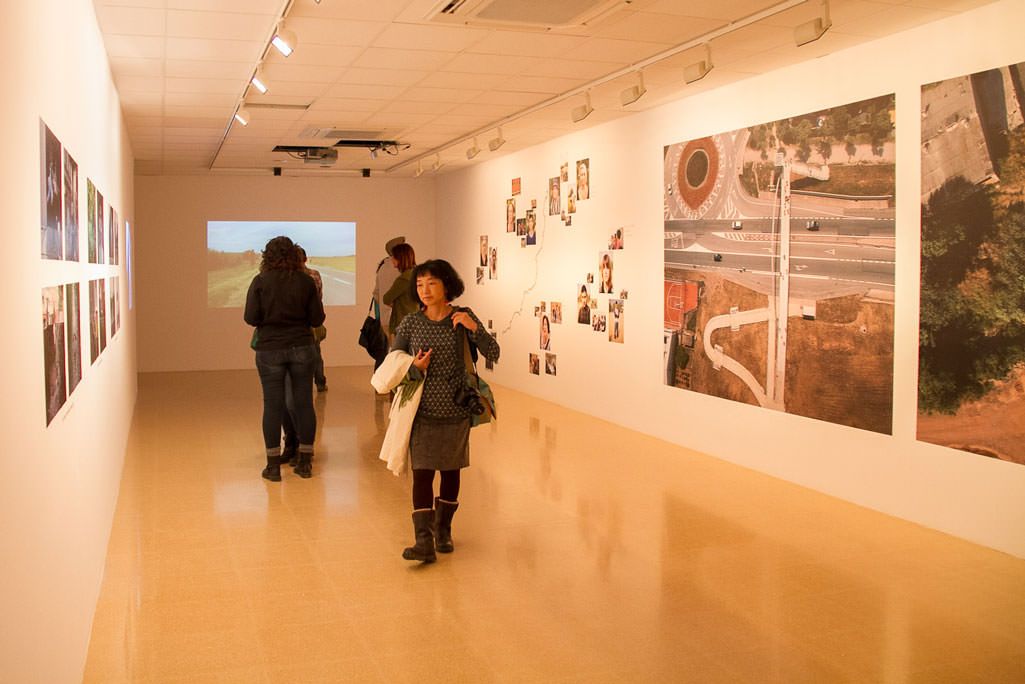UNDER THE SHADOW OF THE OPTIMISM
 08.11.2013 - 13.02.2014
08.11.2013 - 13.02.2014
An exhibition by Atsuko Arai, Curro Claret, Diego Ferrari, Les Salonnières and Tanit Plana
Opening, Friday 8th November at 8 pm
ACVic Centre d'Arts Contemporànies
C/ Sant Francesc, 1. 08500 Vic
Optimism is a state, or an attitude, in which one has a firm expectation that things will go well in spite of obstacles, frustrations or adversity. In current times, immersed in the effects of the global crisis, in which unemployment rates are overwhelming and job insecurity is increasing, in which many people suffer direct and prolonged consequences, in which society is splitting in two, in which rights are being lost at breakneck speed, in which financial powers obscure political powers, in which the distance between political leaders and citizens is increasing, in which the system and institutions are questioned, in which geopolitical tensions are becoming sharper, in which migration is intensifying ... In short, a climate which generates a contagious illness, while also festering by its constant presence and perseverance in the news headlines. Although its effects are uneven around the world, it's guaranteed that the levels of optimism in much of the European population is not at its best. In fact optimism in emerging countries is much higher, because their economies are growing and expectations are improving, although part of this increase is associated with urban speculation, territorial tensions or the exploitation of the underprivileged. A kind of growth and a way of being which reminds us of times which are not so far distant.
Such a scenario casts a shadow which hangs over our social context. A shadow which, on the one hand, prevents us from seeing the light, or the way out, but which on other hand shelters us and forces us to join together and create mechanisms for discussion and cooperation, and especially to consider alternative strategies. Our own survival instinct leads us to believe that things will always be better than they are, we imagine and construct stories which become part of our reality, we engage in projects which generate excitement for the future, and we avoid those who continually insist that everything is too dark. We deploy mechanisms to fight against adversity, and this means channeling ways of overcoming that which stifles and oppresses us. This is optimism, which does not mean denying the complexity of the world, nor escaping from its problems, nor leaving critical attitudes to one side, nor facing life wide-eyed or naively, but rather it means taking a suggestive attitude, looking for specific answers, proposing pathways with a positive outcome.
The title of this exhibition puts forward, in a hypothetical way, the idea that attitude determines how we see things, how we experience them and how we transform them. We do not care to be overshadowed by fatalism, but rather by an optimistic, constructive, imaginative, fresh, bold, involved, creative and hopeful vision. Obviously we are not in the best of all possible worlds, therefore we can not remain passive before this reality. The set of works included in this exhibition share this optimistic, purposeful and constructive vision, and they do so within educational contexts, of learning, knowledge exchange and shared experiences. All projects have developed workshops where work has been configured for collaboration, with varying levels of participation and with different audiences.
Les Salonnières, with the project We need a hero! worked with pupils from various secondary schools in the city of Mataró looking for a hero- or a heroine-figure to solve a problem raised by the pupils, enabling them to use the language of comics and photography to create stories, which were later displayed as posters on advertising hoardings around the city.
Curro Claret has several projects on which he has worked with various groups, some of them at risk of social exclusion. Specifically, with the Fundació Arrels, he worked with homeless people, involving them in the processes of design and construction by generating productive workshops to extend creative attitudes.
Atsuko Arai with Somni Culinari (Culinary Dream) worked with primary school children both inside and outside school. Through workshops, children created imaginary dishes based upon dreams, making them first with inorganic materials, and then later making them for real with the help of chefs. The project has been carried out in Barcelona, Osaka, and in the context of the exhibition in Vic with the collaboration of chef Oriol Sala.
Diego Ferrari with Urban Habitat II has worked with young people in Berlin, with workshops mixing together photography, music and choreography in public spaces. In the city they developed performance activities and converted them into images which were closer to dreamlike fiction and metaphor, an aesthetic interference which provided new readings of these everyday spaces.
Tanit Plana with Circulació (Circulation) began the project with photography and rapidly expanded into education - through the many workshops she has conducted with different groups – as well as expanding into collective performance through a walk which traced the transhumance path from Avignon to Manresa. The project also expands towards collective creation, making all participants into co-producers by creating a collective archive built up during the tour.
- Ramon Parramon
Description of the projects and biographic references
 ATSUKO ARAI
ATSUKO ARAI
SOMNI CULINARI (CULINARY DREAM)
Project in collaboration with Experimentem amb l'Art, Oya Art Village Big Labo i El Gravat, 2012 - in process.
Somni Culinari (Culinary Dream) consists of creating imaginary dishes out of dreams, and turning them into edible dishes. The project develops through creative workshops aimed at families. Participants created imaginary dishes from craft-work as well as recycled materials. Later the dishes were made using edible ingredients which were assembled in the original shape, and coloured with natural dyes. At the same time, the professional chef helped participants and cooked his interpretation of some of the imaginary dishes. In this way, the process of turning an imaginary work into an edible one could be followed, and finally tasted. What do dreams taste like?
Atsuko Arai. Visual artist born in Japan, living and working in Barcelona. She has created projects in different public spaces, underlining the themes perceived according to location. She has created various projects establishing relationships with the local context, presented in the media of video and photography, as well as using other graphic materials. She has also worked in various international artists' residency programmes such as Around the World to Madrid (2002), Memories of Bogota (2005) When in Finland do as the Finns do?! (2006) Els Meus Famosos (2006-2007) i Somni Culinari (2012-13).
 LES SALONNIÈRES
LES SALONNIÈRES
WE NEED A HERO!
Project in collaboration with Ajuntament de Mataró. Mataró, 2013
We need a hero! is a project by the interdisciplinary artistic collective Les Salonieres, developed as part of the sixth edition of Zona Intrusa. In this project is issued the stereotypical image of the teenager - heroine / hero who appears in film and fantasy literature, to meet the challenges and issues which concern young people. Works were shown, as reference models, by contemporary artists such as Carles Congost, Dulce Pinzón, Swati Khurana, Guerrilla Girls or Chicks on Speed, among others, based upon the concept of the hero and heroine. Through discussion, observation, and collective work, pupils' problems were brought to the fore, forming a basis from which to conceive and create super heroes and super heroines specially designed to solve and raise awareness of these problems, which were then staged and photographed as comic-book panels. Once the work in the classroom was finished, the Salonnières made a selection from more than 90 scenes to devise a photonovel in three chapters illustrating the main problems discussed. This was exhibited on advertising spaces in Mataro, and distributed among students as a fanzine.
Utilitzant la estètica del còmic, Les Salonnières proposen un resum d’aquesta experiència en la que van participar els instituts Miquel Biada, Pla d’en Boet, Thos i Codina, the school Pia Santa Anna, the school Gem and the school Freta.
Zona Intrusa 6. We need a hero! is the sixth edition of this educational and cultural project promoted by the Department of Culture of the City of Mataro, which aims to bring contemporary art to teenagers in Mataro.
- Les Salonnières question pre-established discourses such as gender, identity , the body or clothing. We cause disruptions in everyday surroundings to create other possible realities, aiming to create narratives which are subversive to those which dominate in our society. We use performance as an artistic practice, and as a practice allowing us to investigate new forms of knowledge exchange and production. Formally we classify ourselves as an interdisciplinary art collective because of our desire to insert ourselves in disciplines which are foreign to us. such as architecture, theatre, music and fashion. Since 2006 we have been developing artistic and educational projects in parallel.
 TANIT PLANA
TANIT PLANA
CIRCULACIÓ (CIRCULATION)
Project in collaboration with Idensitat i Cal Gras. Manresa i Avinyó, 2012
"The perception of historical time as topography makes the artist interested in the historical story find in the journey an optimal way when it comes to establishing unorthodox connections between spatial and temporal markers of a particular landscape. [...] Such is the case with Tanit Plana and her project, Circulació. This time, her journey is a kind of palimpsest of roads and paths in central Catalonia referring to different historical periods. The initial purpose was to trace the livestock path which until very recent times joined Manresa and Avinyó, and which was part of a transhumance route which facilitated the migration of sheep from Poblet and El Carlit , located in the French Cerdanya. But the discontinuities presented currently by this road, suffering cuts to end up enclosed in private estates, industrial estates, crossed by railway lines and roads, as well as the scarce conservation of many of its sections and the oblivion into which many have fallen, make Tanit's project into a journey where time and space, landscape and memory are combined with considerable promiscuity. "
Oriol Fontdevila, Viatge en ramat, 2013.
Tanit Plana with Circulation began the project with photography and rapidly expanded into education - through the many workshops she has conducted with different groups – as well as expanding into collective performance through a walk which traced the transhumance path from Avignon to Manresa. The project also expands towards collective creation, making all participants into co-producers by creating a collective archive built up during the tour. subjective witnesses of this observatory in motion.
This project was part of "Estètiques Transversals, 2012". Idensitat produced in collaboration with Cal Gras.
- Tanit Plana graduated in Audiovisual Communication and is currently pursuing a Masters in Contemporary Film and Audiovisual at Pompeu Fabra University (Barcelona). She teaches photography at the University Pompeu Fabra and IDEP (Barcelona). Director and conductor of various educational projects related to photography and film with Fundació La Caixa and Centre d'Art Santa Monica, among others. She has received several awards and grants for her artistic research projects.
 DIEGO FERRARI
DIEGO FERRARI
Urban Habitat II Berlín
With the collaboration of Puk a Malta - Kings of Kiez, OKK Gallery Raum 29 i Kiez Kultur Netz- Berlín, 2013
Photographies: Diego Ferrari
Video - Artistic direction: Lluís Andreu Oliver and Diego Ferrari
Music: Junior Jero
Urban Habitat II is a photo and video project by Diego Ferrari documenting the work and music of Kingz of Kiez, a group of up and coming young rappers in Berlin. The iconographic and the everyday collide in the work of London-based fine art photographer Diego Ferrari. For this project Ferrari worked closely with these young people, taking them to iconic public places in Berlin. Together they develop a new expression, which challenges the usual clichés of migration, urban youth and disaffection. Through a playful and questioning approach, Ferrari's work compels the audience to reconsider the inclusive multicultural city.
- Diego Ferrari is an artist and photographer; His work interrogates the relationship between social values and public spaces, with a particular interest in the relationship between the body and its environment, articulating modes of individual and collective experiences and social relations. He exhibits internationally and is co-organiser of the Urban Encounters Symposium at the Tate Britain, and also teaches in the course on “Photography, Art and Architecture” at Central Saint Martins and on the BA in Fine Art Photography at Kingston University.
 CURRO CLARET
CURRO CLARET
ESPAI DE LECTURA (READING LOUNGE)
In collaboration with Fundació Arrels. Vic, 2013 i en procés
The installation has space available for different reading material ( magazines, books, catalogs ...) organised with a central low table, with magazines and reading material, surrounded by a few lamps and some beanbag-type seats. All these pieces were made in different workshops at Arrels Fundació with people who had been living on the street. The work began in 2010, first with stools, lamps and other items of furniture (including the interior of a shop for Camper), later with some daises (there are two of them used as tables ) made for the exhibition Zona intermèdia. Disseny, art i societat al Espai Cultura de Sabadell, and more recently beanbags have been made (as a garbage bag filled with various waste materials). All this work was first proposed as an experiment in which we believe that the design and construction of furniture with materials found in the street can be a means of support and help for the personal and professional development of some of these people.
- Curro Claret. He was trained as an industrial designer in the field of objects. His activity is focused increasingly on projects and processes which attempt to reflect and rethink the relations of individuals to society and the environment (generally understood). He tries to develop this attitude as much within the fields of business and the market as within the contexts of museum and exhibition.








